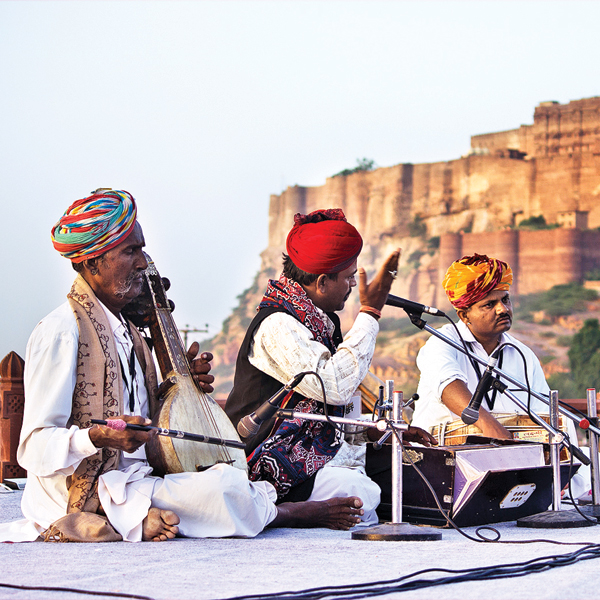It’s a story that regulars at the Rajasthan
International Folk Festival (RIFF), the annual music festival held at
the picturesque Mehrangarh Fort in Jodhpur, love to narrate. It’s the
story, going back some years, of a woman dressed in traditional Rajputi
poshak — skirt and blouse, long scarf draped around the body and head —
on the Zenana Courtyard stage. She had her veil pulled low down over her
face and that’s where it remained throughout her performance,
microphome drawn inside the veil. But any expectation the audience may
have had of the performance reflecting her demure on-stage demeanour was
completely belied when she began singing — such was the raw, stirring
power of her voice.
Today, Bhanwari Devi is a star, her powerhouse vocals, so wonderfully evident in the song Kattey that Bollywood and indie music director Ram Sampath had her sing in Coke Studio some years ago, feted by one and all. She’s travelled the country and world, most notably to the Edinburgh International Festival
where she was invited to sing. Even the face, so completely covered
earlier, is more visible, the veil raised to the forehead instead of
being pulled down to the chest!
Bhanwari Devi’s story, the name she’s made for herself is testimony
to the talent of Rajasthani folk musicians, to how (thanks in large part
to RIFF) their music has found wide appeal around the globe,
transcending geography, language and taste. Her journey is akin to that
of many other Rajasthani folk musicians who’ve played at festivals all
over the world and collaborated with highly regarded musicians from
diverse folk and mainstream traditions. Many of them are globetrotters
with fat passports running into several books!
But Bhanwari Devi is also an exception — she’s the only one among
them who’s a woman. In a conservative society like Rajasthan, especially
among these poor, rural and marginalised musical communities, where
child marriage remains common, where girls’ education is given low
priority and they have little say in their life decisions, women
performers are rare. Bhanwari Devi too was married in her early teens
and has nine children — she’s accompanied in all her performances by her
elder son, who also interacts mostly with the media on her behalf.
But then Bhanwari Devi is a Bhopi, from the Bhopa-Bhopi community,
the only one of the state’s many musician communities where women
perform in public. Unlike the better-known Manganiyars or Langas who
sing in praise of a jajman or patron — traditionally, a member of
royalty or a rich land-owner — the music of the Bhopa-Bhopis has a
ritual, liturgical function. The Bhopa-Bhopi repertoire, called Pabuji
ka Phad, is an oral epic, sung in front of a phad or painted scroll that
celebrates the exploits of Pabuji, a folk deity/war hero, and is
narrated to ward off evils or illness, and bring good fortune. It’s a
“performance” by a male-female — husband and wife — pair, where the male
Bhopa provides the melodic accompaniment on the ravanhatta and cavorts
rhythmically in ghungroos, while the veiled Bhopi stands rigidly next to
him, singing. To look at a Pabuji ka Phad performance, it seems the
Bhopa is in the lead, initiating the performance and pointing with a
stick to the “phad”. But, as scholars and folklorists, who’ve studied
the Pabuji tradition, have noted, it’s the Bhopi who dominates — she
sings the bulk of the epic, and even “designs and moulds the narrative
through her vocal power and emotional force”, to quote Elizabeth
Wickett’s monograph published by Cambridge University’s World Oral
Literature Project.
Contrast this with the Langas and Manganiyars, where the womenfolk
are not allowed to perform in public, or before a male audience. It’s
not that they don’t or can’t sing — the Langa-Manganiyar’s traditional
performative practices had an important role for the women who would
sing indoors, for the women of the jajman’s family, while the men held
forth outdoors. What the proscription on public singing has done is to
effectively exclude women from the tourist, or festival-concert circuit,
where the males are increasingly finding an audience and a livelihood,
given the decline in their traditional modes of patronage. Ironically,
many of the male musicians acknowledge that it is from their mothers
that they first heard and learnt the traditional songs that form their
hereditary repertoire, that it is they who trained their ears in
sur-taal.
But the wings of change are blowing. And the woman credited with
setting them off was a polio-afflicted, physically challenged singer
called Rukma Bai Manganiyar who died some years ago, from lack of access
to health care, according to her sister Akla who used to accompany her
and has now begun performing with a few other Manganiyar women. Rukma,
says Akla, was a fighter. Faced with stiff opposition from her family,
in-laws and the community, and abandoned because of her affliction, she
began singing devotional songs in temples, which brought her to the
attention of outsiders, and set her off on the path to fame and acclaim.
This is a story that’s near identical to what every one of the handful
of women performers who sing regularly today at concerts in RIFF and
elsewhere will tell you — Dariya Manganiyar, for instance, who’s now a
widow with grown sons and has battled a lifetime of opposition, or
Sumitra Devi, a jaagran singer, one of the few who was supported by the
men of her immediate family, her father and now her husband, though the
“samaaj” all but ostracised her.
But the demands of the professional concert stage are very different
from those of the folk musicians’ traditional patrons. It requires a
degree of preparedness — of training and practice, even among a
community that claims an inborn heritage and spontaneous talent — that
passes the test of microphones and expensive acoustic systems that pick
up and amplify even the smallest of off-notes. Akla, Dariya and the
other female Manganiyar singers who now are making it to concerts and
claiming their share of the acclaim that’s been hogged thus far by their
menfolk have a long way to go here, to smoothen out the rough edges of
their talent. But will their society allow them the space and time for
it ?
The author is features editor at DNA
Source : DNA , 6th Nov 2015
Source : DNA , 6th Nov 2015


No comments:
Post a Comment